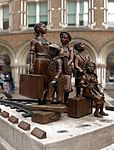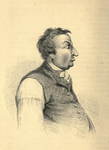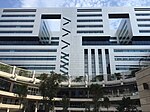Liverpool Street station

Liverpool Street station, also known as London Liverpool Street, is a central London railway terminus and connected London Underground station in the north-eastern corner of the City of London, in the ward of Bishopsgate Without. It is the terminus of the West Anglia Main Line to Cambridge, the Great Eastern Main Line to Norwich, commuter trains serving east London and destinations in the East of England, and the Stansted Express service to Stansted Airport. The station opened in 1874, as a replacement for Bishopsgate station as the Great Eastern Railway's main London terminus. By 1895, it had the most platforms of any London terminal station. During the First World War, an air raid on the station killed 16 on site, and 146 others in nearby areas. In the build-up to the Second World War, the station served as the entry point for thousands of child refugees arriving in London as part of the Kindertransport rescue mission. The station was damaged by the 1993 Bishopsgate bombing and, during the 7 July 2005 bombing, seven passengers were killed when a bomb exploded aboard an Underground train, just after it had departed from Liverpool Street. Liverpool Street was built as a dual-level station, with provision for the Underground. A tube station opened in 1875 for the Metropolitan Railway; it is now served by the Central, Circle, Hammersmith & City and Metropolitan lines, and which will be joined by the Elizabeth line from 24 May 2022. It is in fare zone 1 and is managed directly by Network Rail.
Excerpt from the Wikipedia article Liverpool Street station (License: CC BY-SA 3.0, Authors, Images).Liverpool Street station
Great Eastern Walkway, City of London
Geographical coordinates (GPS) Address Nearby Places Show on map
Geographical coordinates (GPS)
| Latitude | Longitude |
|---|---|
| N 51.5186 ° | E -0.0813 ° |
Address
London Liverpool Street Platforms 8 & 9
Great Eastern Walkway
EC2A 2JN City of London
England, United Kingdom
Open on Google Maps










